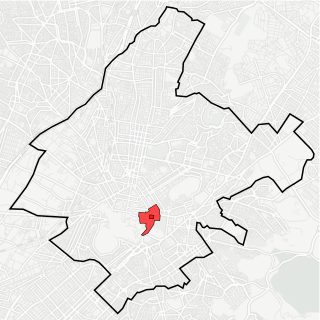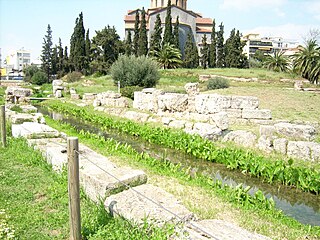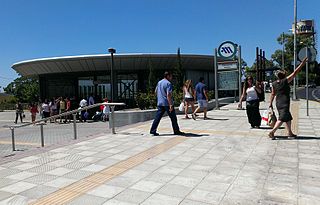
Athens is the capital city of Greece. With a population close to 4 million it is the largest city in Greece, and the 7th largest city in the European Union. Athens dominates and is the capital of the Attica region and is one of the world's oldest cities, with its recorded history spanning over 3,400 years and its earliest human presence beginning somewhere between the 11th and 7th millennia BC.

The Athens Metro is a rapid-transit system in Greece which serves the Athens urban area and parts of East Attica. Line 1 opened as a conventional steam railway in 1869 and electrified in 1904. In 1991, Attiko Metro S.A. constructed and extended Lines 2 and 3. It has significantly changed Athens by providing a much-needed solution to the city's traffic and air pollution problem, as well as revitalising many of the areas it serves. An extension of Line 3 is under construction towards Piraeus and also other extensions of existing lines, as well as a new Line 4, whose central section began construction in October 2021. The Athens Metro is actively connected with the other means of public transport, such as buses, trolleys, the Athens Tram and the Proastiakos Athens suburban railway. The Athens Metro is hailed for its modernity and many of its stations feature works of art, exhibitions and displays of the archeological remains found during its construction. Photography and video-taking is permitted across the whole network and street photographers often work in Athens Metro. This is the only metro system in Greece, until the Thessaloniki Metro begins operation in 2023.

Syntagma Square is the central square of Athens. The square is named after the Constitution that Otto, the first King of Greece, was obliged to grant after a popular and military uprising on 3 September 1843. It is located in front of the 19th century Old Royal Palace, housing the Greek Parliament since 1934. Syntagma Square is the most important square of modern Athens from both a historical and social point of view, at the heart of commercial activity and Greek politics. The name Syntagma alone also refers to the neighbourhood surrounding the square. The metro station underneath the square, where lines 2 and 3 connect, along with the tram terminal and the numerous bus stops, constitutes one of the busiest transport hubs in the country.

The Syntagma station of Athens Metro is located at Syntagma Square in the centre of Athens, Greece. It serves as the transfer point between Line 3 and Line 2. It also serves as a connection point to the Athens Tram. When the Metro first opened, on 28 January 2000, the station was the terminal station for both the new lines. It is a transportation hub for O.SY. buses and the northern terminal for the Tram. It is the busiest station in the Athens transport system, located underneath Syntagma Square, the busiest in Athens. It serves Ermou Street, a pedestrian street full of commercial activity and one of the priciest shopping areas in Europe. The station serves the Houses of Parliament and various government agencies, foreign embassies and the National Garden.

Eridanos or Eridanus was a river in Athens mentioned in Greek mythology and historiography.

Panepistimiou Street is a major street in Athens that has run one way for non-transit vehicles since 2002 from Vasilissis Amalias Avenue, Syntagma Square and Vassilissis Sofias Avenue to Omonoia Square in which is now a pedestrian crossing and before an intersection. Its total length is about 1.2 km. The street was formally renamed as Eleftherios Venizelos Avenue in 1945 but is still usually known by its historical name. It has six lanes, of which five are for traffic and one eastbound lane for transit buses only. Most of the street runs almost diagonally from southeast to northwest.

Stadiou Street is Athens' major street linking the Omonoia and Syntagma Squares. It runs diagonally and is one-way from northwest to southeast. The street is named after the ancient Panathenaic Stadium located about 3 km southeast of the downtown core and is aligned directly with the ancient stadium.

Vasilissis Sofias Avenue is a major avenue in the east side of Athens, the Greek capital. The avenue was originally part of the Kifisias Avenue. The part from Syntagma Square to the intersection with Alexandras Avenue was renamed after Queen Sophia, the consort of King Constantine I. The avenue begins at the intersections of Amalias Avenue and Panepistimiou Street and ends by Alexandras, Kifissias and Mesogeion Avenues as well as Feidippou Street, with a total length of approximately 3 km. A section of the avenue is part of the old GR-1, and a branch of GR-54.

Koukaki is a southeast neighbourhood of the Municipality of Athens, Greece.

The National Art Gallery is an art museum located on Vasilissis Sofias avenue in the Pangrati district, Athens, Greece. It is devoted to Greek and European art from the 14th century to the 20th century. It is directed by Marina Lambraki-Plaka.

The Numismatic Museumof Athens is one of the most important museums in Greece and it houses a collection of over 500,000 coins, medals, gems, weights, stamps and related artefacts from 1400BC to modern times. The collection constitutes one of the richest in the world, paralleled by those of the British Museum in London, the Bibliothèque Nationale in Paris, the State Hermitage Museum in St. Petersburg, the Bode Museum in Berlin, and the American Numismatic Society in New York. The museum itself is housed in the mansion of the archaeologist Heinrich Schliemann, formally known as Iliou Melathron.

Akadimia, literally "Academy", is a neighborhood in central Athens, Greece.
Syntagma (σύνταγμα), a Greek word meaning "arrangement" in classical Greek and "constitution" in modern Greek, may refer to:
The Athens Tram is the modern public tram network system serving Athens, Greece. It is owned and operated by Urban Rail Transport (STASY) S.A..

Ermou Street is a one and a half kilometer-long road in central Athens, Greece, connecting Kerameikos archaeological site with the Syntagma Square through Monastiraki, Psiri and Thiseio.

The Old Royal Palace is the first royal palace of modern Greece, completed in 1843. It has housed the Hellenic Parliament since 1934. The Old Palace is situated at the heart of modern Athens, facing onto Syntagma Square.

Athens railway station is the main railway station of Athens, and the second largest station in Greece. Located in the central quarter of Kolonos, it resulted from the merger of the city's two main railway terminals—the Larissa Station of the Piraeus–Platy railway towards central and northern Greece, and the Peloponnese Station of the Piraeus–Patras railway linking Athens with the Peloponnese. It is still colloquially known as Larissa Station, which is also the name of the adjacent Metro station.

Elliniko metro station in Athens is the current southern terminus on Athens Metro Line 2 since the Elliniko extension opened on 26 July 2013. With the opening of the station, travel time from Elliniko to Syntagma Square was reduced from 45 minutes to 20 minutes.
Venizelou is an under-construction metro station serving Thessaloniki Metro's Line 1 and Line 2. The station is named after Eleftherios Venizelos, Liberal Prime Minister of Greece. It is expected to enter service in 2023. Construction of this station has been held back by major archaeological finds, and it is designated as a high-importance archaeological site by Attiko Metro, the company overseeing its construction. At this station, Roman Thessaloniki's marble-clad and column-lined Decumanus Maximus, along with shops and houses, was found running along the route of the Via Egnatia at 5.4 metres (18 ft) below ground level.

Aghia Sofia is an under-construction metro station serving Thessaloniki Metro's Line 1 and Line 2. The station is named after the church of Hagia Sophia, located nearby. It is expected to enter service in 2023 Construction of this station has been held back by major archaeological finds, and it is designated as a high-importance archaeological site by Attiko Metro, the company overseeing its construction. Here, as well as at Venizelou, Roman Thessaloniki's marble-clad and column-lined Decumanus Maximus, along with shops and houses, was found running along the route of the Via Egnatia at 5.4 metres (18 ft) below ground level. Additionally, a public square was also found at this station. The discovery was so major that it delayed the entire Metro project for years. A historian dubbed the discovery "the Byzantine Pompeii".

















